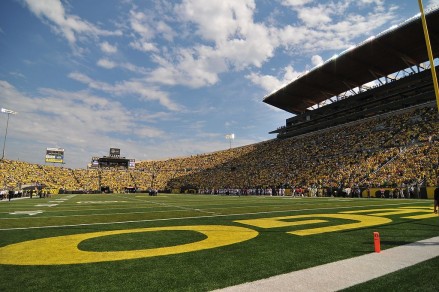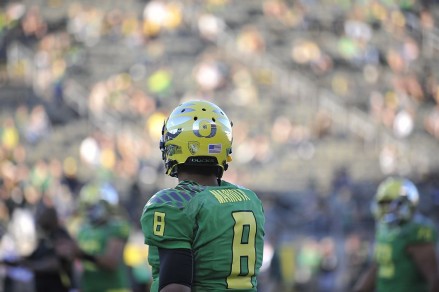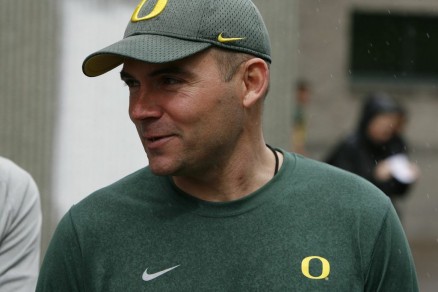This multi-week series will attempt to take a reasonable, logical and unbiased look at Oregon’s recent recruiting successes and failures while analyzing the program’s recruiting philosophy under Chip Kelly. The series will then look at how that philosophy already has and may continue to evolve under Mark Helfrich before ending with a detailed breakdown of the author’s ideal recruiting blueprint.
Part 1: What Happened in 2012-2013
Part 2: What Went Wrong
Part 3: What Went Right: The Oregon Brand
Part 4: A Philosophical Shift
“I can’t imagine that this recruiting class isn’t going to be awesome.” I was caught by surprise. This is the type of thing you hear on an Oregon message board from an over-optimistic fan, not a program insider who’s always quick to call a spade a spade. Nonetheless, this comment came during a conversation about Oregon’s future recruiting efforts under head coach Mark Helfrich. Note that this wasn’t said lightly; it came amidst a number of eye-opening accounts detailing Oregon’s past recruiting failures. The bottom line, the insider said, is that “Helfrich isn’t going to let Oregon get out-worked. They might not get every kid they want, but it won’t be because another school worked harder.”
The fact that Mark Helfrich told his staff that they will “never again” be out-worked on the recruiting trail is significant. Any Oregon fan who understands the logistics of recruiting will tell you that hearing such a thing is music to their ears. As outlined in the 3rd part of this series, the Oregon football program has a lot going for it on the recruiting trail. Thanks to the Oregon brand, blue-chip recruits from all over the nation have significant interest in the program. Few schools garner as much national attention (Ohio St., USC, Alabama, and Notre Dame, for example), thus the potential is there for the Ducks to become a recruiting power, even if it is somewhat limited by location (the #1 factor in recruiting success at the BCS level). To realize that potential, however, means working at least as hard as the blue bloods, something Helrich appears prepared to do.
As noted in part 4 of this manifesto, Oregon’s approach to recruiting became significantly more aggressive when Mark Helfrich took over as head coach. While some of this was born out of necessity, some was based on a fundamentally different approach to recruiting from the approach used in the Chip Kelly era. This philosophical shift has already been apparent early in the 2014 cycle. Oregon is actively pursuing a much larger number of recruits than they ever did under Chip Kelly this early in the process. While the Ducks still aren’t offering to a large number of recruits (they’ve officially offered around 40 players, while programs like Alabama, LSU, Notre Dame, Ohio State, Michigan and Oklahoma have all offered over 100), they are building a large number of critical relationships, giving the coaches more time to evaluate prospects before deciding which players would be the best fit for the program.
So what do we know about Oregon’s “new” philosophy? In spite of the aforementioned desire to work harder, the change isn’t going to be obvious to the casual fan; it’s not going to be night and day. Oregon still isn’t going to throw out a large number of offers to see what sticks. They will continue the thorough evaluation process that has proved to be quite successful. If Oregon offers a player, then the coaches trust that he is a high-character guy who will fit into the culture and is talented enough to (eventually) make significant on-field contributions. As Helfrich put it, “we aren’t going after rehab projects.” Additionally, we know that the staff is making an effort to start the recruiting process earlier than ever before in order to keep up with the changing recruiting landscape, where more and more players are making early decisions. They’re also “widening the net” by building more relationships with recruits than they have in the past. The hiring of Matt Lubick was a widely acclaimed move that also signifies a more aggressive approach, seeing as the new Oregon wide receivers coach is known for his recruiting prowess. It’s worth mentioning that Lubick will act as the offensive recruiting coordinator according to multiple sources within the program.
So, given this “new” philosophy, what exactly should Oregon fans expect? Are the changes going to be significant? What is Oregon’s recruiting ceiling, and how high can the team be realistically expected to finish in the rankings? Does it even matter?
It’s fair and reasonable to have some expectations. If the Ducks keep winning on the field, they’ll improve on the recruiting trail. While outwardly, there might not appear to be many changes, the philosophical shift will prove significant. The staff’s more aggressive approach – namely, casting a wider net and working harder – combined with the additions of Lubbick and new defensive line coach Ron Aiken (two guys who know how to recruit), will produce results. Now, Oregon will probably never be a perennial top-10 finisher (in the recruiting rankings) due to the relatively small number of blue-chip recruits within 250 miles of campus, but top-15 is certainly possible given their reputation among the nation’s elite high school players. Does it matter? Yes and no. Yes, recruiting absolutely matters and arguing against that fact is akin to saying the earth is flat. However, games are ultimately won on the field. We know that the team with more talent (as dictated by recruiting rankings) has a distinct advantage, but that doesn’t always translate into wins. Converting recruiting success to on-field success is what separates the great (Alabama) from the overhyped (Texas). If Oregon can finish in the top-15 year-in and year-out, they will put themselves in position to compete with the nation’s best.
We’ll know more about Oregon’s overall recruiting strategy under coach Helfrich by this time next year, but there’s already quite a bit that’s apparent. The Ducks will continue to thoroughly evaluate every prospect they offer, but those evaluations will no longer prevent them from building key relationships with a larger number of players early in the process. These relationships should lead to more successful recruitments down the line and prevent Oregon coaches from settling for backup options later on in the cycle. With a commitment to never be outworked on the recruiting trail, and a brand that excites blue-chip recruits nationwide, Oregon football is in great shape to solidify its status among the nation’s elite programs in the years to come.
Related Articles:
Chip Kelly Update: Everything's Good Again ...
Chip Kelly Update: Wailing and Gnashing of Teeth
Shock and Awe -- The Oregon Ducks' Football Hangover Effect
Despite Lopsided Score, Georgia State "Never Stopped Believing"
Hope Springs Eternal for Ducks
Incompetent Pac-12 Officials: How Do You Miss ALL of THIS?
Chris was born in Montevideo, Uruguay, but made his way to Oregon by the age of five, when he attended his first game at Autzen Stadium. A huge sports fan at a young age, Chris grew up playing football, basketball and golf. Although realizing he isn’t likely to play in the NFL or NBA, Chris still holds on to hopes of being a professional golfer should his unfortunate putting woes take a turn for the better. A bit of a platypus, he attended both Oregon State and Oregon during his collegiate days where he earned a business degree in Finance and Business Administration. Chris works for Daimler Trucks North America in Portland, and plans to get his MBA from the University of Oregon.
Chris has been an active member in the recruiting community since 2005. He studies the intricacies of recruiting and is particularly intrigued by talent evaluation techniques. He is currently working on developing his own scouting reports for every scholarship player on the UO roster. Chris lives with his wife, Katrina, and his two-year-old son Lucas (a future dual-threat QB).



